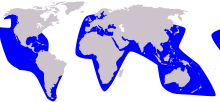
Back الحوت القاتل الكاذب Arabic الحوت القاتل الكاذب ARZ Binjol (Pseudorca crassidens) AVK Лъжекосатка Bulgarian Falsskoazog Breton Orca falsa Catalan Pseudorca crassidens CEB Kosatka černá Czech Coegleiddiad Welsh Halvspækhugger Danish
| False killer whale Temporal range: Middle Pleistocene–Recent[1]
| |
|---|---|

| |

| |
| Size compared to an average human | |
| Scientific classification | |
| Domain: | Eukaryota |
| Kingdom: | Animalia |
| Phylum: | Chordata |
| Class: | Mammalia |
| Order: | Artiodactyla |
| Infraorder: | Cetacea |
| Family: | Delphinidae |
| Genus: | Pseudorca |
| Species: | P. crassidens
|
| Binomial name | |
| Pseudorca crassidens (Owen, 1846)
| |

| |
| Range of the false killer whale | |
| Synonyms[4] | |
|
List of synonyms
| |
The false killer whale (Pseudorca crassidens) is a species of oceanic dolphin that is the only extant representative of the genus Pseudorca. It is found in oceans worldwide but mainly in tropical regions. It was first described in 1846 as a species of porpoise based on a skull, which was revised when the first carcasses were observed in 1861. The name "false killer whale" comes from having a skull similar to the orca (Orcinus orca), or killer whale.
The false killer whale reaches a maximum length of 6 m (20 ft), though size can vary around the world. It is highly sociable, known to form pods of up to 50 members, and can also form pods with other dolphin species, such as the common bottlenose dolphin (Tursiops truncatus). It can form close bonds with other species, as well as have sexual interactions with them. But the false killer whale has also been known to eat other dolphins, though it typically eats squid and fish. It is a deep-diver; maximum known depth is 927.5 m (3,043 ft); maximum speed is ~ 29 km/h (18 mph).
Several aquariums around the world keep one or more false killer whales, though its aggression toward other dolphins makes it less desirable. It is threatened by fishing operations, as it can entangle in fishing gear. It is drive hunted in some Japanese villages. The false killer whale has a tendency to mass-strand given its highly social nature; the largest stranding consisted of over 800 beached at Mar del Plata, Argentina, in 1946. Most of what is known of this species comes from examining stranded individuals.
- ^ "Pseudorca crassidens". Fossilworks. Gateway to the Paleobiology Database. Retrieved 11 August 2018.
- ^ Baird, R.W. (2018). "Pseudorca crassidens". IUCN Red List of Threatened Species. 2018: e.T18596A145357488. doi:10.2305/IUCN.UK.2018-2.RLTS.T18596A145357488.en. Retrieved 13 November 2021.
- ^ "Appendices | CITES". cites.org. Retrieved 14 January 2022.
- ^ Perrin WF (ed.). "Pseudorca crassidens". World Cetacea Database. World Register of Marine Species. Retrieved 4 August 2018.
© MMXXIII Rich X Search. We shall prevail. All rights reserved. Rich X Search
